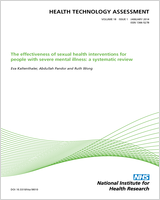Included under terms of UK Non-commercial Government License.
NCBI Bookshelf. A service of the National Library of Medicine, National Institutes of Health.
Williams NH, Roberts JL, Din NU, et al. Developing a multidisciplinary rehabilitation package following hip fracture and testing in a randomised feasibility study: Fracture in the Elderly Multidisciplinary Rehabilitation (FEMuR). Southampton (UK): NIHR Journals Library; 2017 Aug. (Health Technology Assessment, No. 21.44.)

Developing a multidisciplinary rehabilitation package following hip fracture and testing in a randomised feasibility study: Fracture in the Elderly Multidisciplinary Rehabilitation (FEMuR).
Show details| Theory area 1: individual patient | Theory area 2: team delivering the intervention | Theory area 3: the rehabilitation intervention | Theory area 4: setting for the intervention |
|---|---|---|---|
|
|
|
|
- Initial framework for coding transcripts - Developing a multidisciplinary rehabi...Initial framework for coding transcripts - Developing a multidisciplinary rehabilitation package following hip fracture and testing in a randomised feasibility study: Fracture in the Elderly Multidisciplinary Rehabilitation (FEMuR)
- Rattus norvegicus hydroxyacyl-Coenzyme A dehydrogenase/3-ketoacyl-Coenzyme A thi...Rattus norvegicus hydroxyacyl-Coenzyme A dehydrogenase/3-ketoacyl-Coenzyme A thiolase/enoyl-Coenzyme A hydratase (trifunctional protein), alpha subunit (Hadha), mRNAgi|18677762|ref|NM_130826.1|Nucleotide
Your browsing activity is empty.
Activity recording is turned off.
See more...